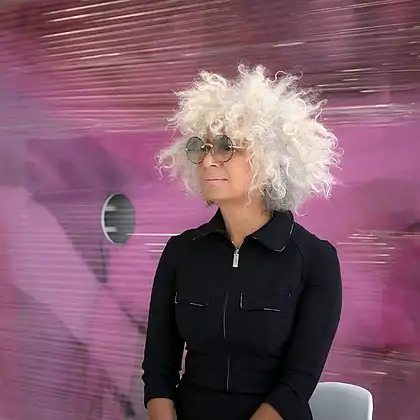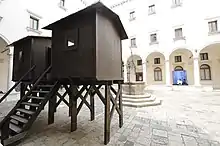Owanto
Owanto is a contemporary artist of Gabonese origin (born December 13, 1953 in Paris).[1]
| Born | December 13, 1953 |
| Nationality | British |
| Occupation | Multidisciplinary Artist |
| Known For | Art and Activism Work on Female Genital Mutilation/ Cutting (FGM/C)
Monumental Photographs |
| Children | Charles Berger (Entrepreneur)
Katya Berger (Independent Documentary Filmmaker and Contemporary Art producer) |

Biography
Owanto grew up in Libreville, Gabon, where she spent her formative years, and eventually moved to Europe to study Philosophy, Literature and Languages at the Institut Catholic de Paris in Madrid, Spain.
Her artistic practice emerges from a 30+ year career engaging with consciousness through the notion of memory, both personal and collective, and exploring cross-cultural and trans-historical dialogues to interrogate the meaning of existence, as well as of her personal and shared history. Owanto’s current projects focus on the female condition, emancipation and the breaking of silence. Her work on this matter reflects upon the psychological concept of resilience by exploring the notion of healing, repair and transformation.
Owanto's creative force stems from her belief in the ability of art to transform consciousness. Her work sheds new light on difficult and relevant issues which prevent us from ignoring what takes place around us. Owanto's concern for social issues has compelled her to campaign for relevant but uncomfortable and often ignored topics. She believes that modern art has a role to play in changing cultural norms.
In 2009, Owanto represented the Republic of Gabon at the 53rd Venice Biennale with a solo show entitled The Lighthouse of Memory - Go Nogé Mènè, curated by Fernando Francès, being the very first artist from Central Africa to exhibit solo in a National Pavilion. Through the use of archives and found documents, her proposal traced the past to shape the future, honouring the title Go Nogé Mènè which means Building the Future in her mother tongue. Owanto states that, "Gabon was looking for new directions, as was the rest of the world - new systems, new models of society, new ways of seeing.” Central to her artistic proposal was the question “Où Allons Nous?” (Where Are We Going?) - A poetic, omnipresent, important, fundamental and universal probe.


Work
Owanto has used pop, conceptual and minimal art in her creation of universal symbols, which remind spectators of where the solutions to our world may lie, and how a society lacking moral strength may begin to heal. Using her sculptures as starting points, Owanto has created a series of icons which she presents in highly technical formats such as light-boxes and traffic signs - media previously explored by Maurizio Cattelan, Rogelio López Cuenca, Gabriel Acuña and Michael Pinsky. “Owantoʼs discourse focuses on images of a family group and a child playing, which suggest a happier world to come. The pieces have a double intention: to alert us to solutions to our global predicament, and to suggest a change in governing attitudes and rules. The light-boxes, like torches and lighthouses, illuminate a future characterised by tolerance, unity and hope."[2]
The ‘Flowers Project’ is one that Owanto started 6 years ago, after discovering some old photographs in a forgotten drawer. Highlighted in this project are the fundamental questions concerning the future of women and girls and their rights to have a say over their own bodies – regarding particularly the practice of Female Genital Mutilation/Cutting (FGM/C). She strives to bring to light the complex and contested issues surrounding this practice, which is often done in discreet initiation ceremonies around the world, as an age-old ritual signifying the important transition from childhood to womanhood by curbing sexual desire.
A summary of the Flowers Project is as follows: It consists so far of 4 bodies of work.
Flowers Series:
Owanto retrieves archival photographs of an FGM/C ceremony, and enlarges them up to 2x3 meters high. She then disrupts the violation in the images by removing the sections deemed most private, through covering the void with delicate, hand crafted, and cold porcelain flower sculptures. The physical act of removing the flower, the “deflowering”, momentarily exposes the viewer to the truth. The flower is a symbolic cover-up that masks the identity of these young girls — an identity that was taken away from them — and hides this very loss. The original image is transformed to enable the young women in the old image to embody a different narrative.
One thousand Voices
One Thousand Voices is an immersive sound installation, produced by Owanto in collaboration with Katya Berger, which amplifies an ensemble of voices collected from around the world. It is a collection of audio testimonies from Female Genital Mutilation/Cutting (FGM/C) survivors. Using various languages, some speaking anonymously, most testifying openly, the installation projects sounds and stories of survival and resilience. The voices weave together to create one collective narrative.
While the flower poetically plays a healing role and attempts to metaphorically change the narrative in Flower Series —from victims to heroines— the collective voice of women and girls united to say “no more” in One Thousand Voices breaks the silence and literally changes the narrative.
Pardonne Moi
Pardonne-Moi is produced in collaboration with reformed cutters/circumcisers from the Kolda Region in South Senegal and from Cross River State in Nigeria. Women who have abandoned the knife to adopt the needle are changing their destiny as they weave the words of liberation voiced by the heroines in One Thousand Voices. On the one hand is the notion of healing and on the other hand, is the notion of pardon or atonement.
The use of a new medium, material and embroidery, needle instead of knife, is explored, as well as the relationship between the spoken, the written word, and the enlightened word. The yellow thread symbolizes transformation. In this exceptional act of solidarity all women are united.
Field of Light
In this neon series, the painful testimonies of FGM/C survivors are re-appropriated and turned into light messages. The oral words are materialized into illuminated written words, offering a way out from the shadows, and suggests transformation and healing.
Awards and Honors
Owanto had the honor of representing the Republic of Gabon at the 53rd International Art Exhibition of the Venice Biennale in 2009, with a solo show in Gabon's first National Pavilion. She is one of the winners of the Mbokodo Awards from South Africa for 2020. “The awards honor women who have strengthened communities and individuals through their art.”[3]
Exhibitions
Solo Exhibitions:
2020: "La Bible de ma Mère" LagosPhoto20, Online Home Museum
2020: "Flowers" Sakhile&Me, Frankfurt, Germany
2019: "One Thousand Voices" Zeitz Museum of Contemporary Art Africa (Zeitz MOCAA), Cape Town, South Africa
2019: "One Thousand Voices" Museo d'Arte Contemporanea Donnaregina (MADRE), Naples, Italy
2018: "Flowers" Voice Gallery, Marrakech, Morocco
2018: "Dance with Me" African Artist's Foundation (AAF), Lagos, Nigeria
2016: "Flowers" Conseil National, Monaco, Monaco
2015: Owanto " L'Atelier de l'artiste", Art Marbella (Galeria Yusto-Giner), Marbella, Spain
2014: "Here, Now." Biennale de Marrakech, Marrakech, Morocco
2013: "Protect" (Public art intervention), Jardins de Saint Martin, Monaco, Monaco
2012: "Où Allons Nous?" Voice Gallery, Marrakech, Morocco
2011: "El Faro de la Memoria" Galería Maior, Vigo, Spain; Palma de Mallorca, Spain
Group Exhibitions:
2020: "Group Show", 1-54 Contemporary African Art Fair (Sakhile&Me), London, UK
2019: "Material Insanity", Museum of African Contemporary Art Al Maaden (MACAAL), Marrakech, Morocco
2018: "Our Anthropocene: Eco Crises", The Center for Book Arts, New York, United States
2018: "Group Presentation", 1:54 Contemporary African Art Fair London (Voice Gallery), London, UK
2017: "Group Presentation", LagosPhoto, Lagos, Nigeria
2017: "Group Presentation", AKAA Also Known as Africa Art Fair (Voice Gallery), Paris, France
2017: "Group Presentation", 1:54 Contemporary African Art Fair London (Voice Gallery), London, UK
2017: "All Things Being Equal..." Zeitz Museum of Contemporary Art Africa (Zeitz MOCAA), Cape Town, South Africa
2016: "Group Presentation" 1:54 Contemporary African Art Fair London (Voice Gallery), London, UK
2016: "Beauty", Centro de Exposiciones de Benalmádena, Benalmádena, Spain; MAD Antequera, Málaga, Spain
2016: "Made in Spain. Periplo por el arte español de hoy", MAD Antequera, Málaga, Spain
Publications
- Thelma Mort (2020): Getting out of forgotten: The disruptive vision of Owanto, Agenda, DOI: 10.1080/10130950.2020.1833512
- Berrada, Meriem; Dieudji, Janine G.; Diagne, Souleymane B. and Zineb A. Arraki. 2019. Material Insanity. Casablanca, Morocco: Somadi. ISBN 978-9-95470-804-0.
- DeSouza, Allan; Milbourne, Karen; Mutu, Wangechi; Osodi, George and Clive van den Berg. 2013. Earth Matters: Land as Material and Metaphor in the Arts of Africa. New York, USA: Monacelli Press. ISBN 978-1-58093-370-4.
- Frances, Fernando. 2009. Owanto: The Lighthouse of Memory - Go Nogé Mènè. Imola, Italy: Maretti Editore. ISBN 978-8-88996-572-6.
- Sherman, Louise. 2002. Owanto. Barcelona, Spain: Polígrafa. ISBN 978-8-43430-934-0.
- Benetton, Luciano; Frances, Fernando and Helena Juncosa. 2014. Identity/Modernity: Contemporary Artists from Spain. Treviso, Italy: Fabrica. ISBN 978-8-89876-444-0.
References
- "Owanto: A Thousand Voices, But Two Thousand Feet" by Valentine Umansky, ART AFRICA, July 2020
- "Owanto: 30 years of militantisme en faveur de l'émancipation de la femme" by Stevie Mounombou, Gabonreview, July 2020
- "Owanto: An artist who asks you to look and reflect" by Emilie Gambade, Daily Maverick, July 2020
- "Something Terrible Happened To Me When I Was Seven", ELLE, February 2019
- "Le dire avec des fleurs", Diptyk n ° 47, February-March 2019
- "Fleurs guérisseuses et voix briseuses de silences", Afrique in visu, February 2019
- "Les Fleurs du Bien", ELLE, February 2018
- "Fleurs et Blessures - Entretien avec Owanto", IAM (Intense Art Magazine), January 2018
- "Owanto's Flower Series", AFRICANAH, December 2017
- "The Forgotten Drawer," ART AFRICA, December 2017
- Fernando Francés, Owanto The Lighthouse of Memory Go Nogé Mènè, Christian Maretti Editore, 2009, pp 12-13.
Footnotes
- "Owanto". Galeria Maior.
- (Fernando Francés, Owanto The Lighthouse of Memory Go Nogé Mènè, Christian Maretti Editore, 2009, pp 12-13)
- http://www.mbokodoawards.co.za/